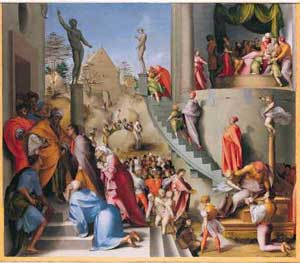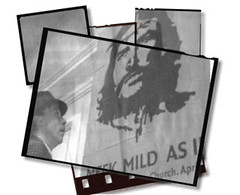The Exilic thought in the Testament of the Patriarchs.
 The Testaments of the Twelve Patriarchs were probably written in the second half of the second century c.e. or the beginning of the third century c.e. [1] There is debate on whether the Testaments should be considered Jewish works with Christian additions or whether they should be just be read as origination from a Christian group. [2] Whoever the originators of these texts were, we can be certain that the person(s) in question know these Jewish traditions and find them useful for their own purposes.[3] The Testaments themselves are written from the perspective of one of the various named patriarchs and are meant to give the readers moral advice to follow after the patriarch’s own death so that the readers might be faithful and obedient.
The Testaments of the Twelve Patriarchs were probably written in the second half of the second century c.e. or the beginning of the third century c.e. [1] There is debate on whether the Testaments should be considered Jewish works with Christian additions or whether they should be just be read as origination from a Christian group. [2] Whoever the originators of these texts were, we can be certain that the person(s) in question know these Jewish traditions and find them useful for their own purposes.[3] The Testaments themselves are written from the perspective of one of the various named patriarchs and are meant to give the readers moral advice to follow after the patriarch’s own death so that the readers might be faithful and obedient.
Throughout most of the Testaments is a section that rehearses the sin-exile-return/restoration framework (henceforth, SER). The repetition of the SER passages serves to describe the history of the descendents of the patriarchs till the coming restoration.[4] In some cases the SER passages are expanded and employ the sin-punishment-repentance-salvation scheme that are common to earlier apocalypses, usually specified as sin-exile-repentance-return. These sections of the Testaments are perhaps the most stereotyped and contain many parallels to one another. They can be very short, and their content can be very general.[5]
The return/restoration portion of the Testaments can include not only the appearance of an anointed priest and/or king, the binding of Beliar, the return from Dispersion, and the salvation of the Gentiles, but also resurrection from the dead and life in a new Jerusalem and/or in paradise.[6]
In the sin sections much of the sin has to do with the general impiety of Israel and their disobedience to the ordinances of God, and in many of the Testaments this treatment is very short and general.[7] In other testaments the list of sins are given in considerable amount of detail and include such things as witchcraft, intercourse with prostitutes, intermarriage, the giving up of agriculture, and following the ways of the sons of Levi.[8] Many of these specific sins are often hard to match up with any known period in the history of Israel, or even in the later Christian era.[9]
The consequences for sin are conveyed in terms of conquest and in exile. Again this is either described in historical terms as the loss of the sanctuary, forced exile, and the judgment of God; or in greater detail as the Testament of Judah describes:
In response to this the Lord will bring you famine and plague, death and the sword, punishment by a siege, scattering by enemies like dogs, the scorn of friends, destruction and putrefaction of your eyes, slaughter of infants, the plunder of your sustenance, the rape of your possessions, consumption of God’s sanctuary by fire, a desolate land, and yourselves enslaved by the gentiles. And they shall castrate some of you as eunuchs for their wives.[10]
What is common to all the Testaments is that punishment always connotes a forced exile. Often the idea of exile can be explained in the pseudo-historical interest of the Testaments and the figures themselves looking to the future ‘historical’ exile.[11] Yet there are places in the Testaments that specifically warn the present and future generations about the result of these sins, so that when these things happen they will repent quickly. [12] The Testaments are pretty uniform in that repentance must take place before the mercy of the Lord’s restoration will be experienced. Though the restoration itself is hardly uniform; some of the Testaments have in view a physical return to the land in a future time and within history,[13] while others see the period of exile only ending at the eschatological end of days.[14] Despite these radical differences the time of exile and captivity is still an ongoing reality for the Testaments.
[1] H. W. Hollander and M. De Jonge, The Testaments of the Patriarchs: A Commentary (Leiden: Brill, 1985), 82-85.
[2] Robert A. Kraft, "The Pseudepigrapha in Christianity " in Tracing the Threads: Studies in the Vitality of Jewish Pseudepigrapha, ed. John C. Reeves (Early Judaism and its Literature 6; Atlanta: Scholars Press, 1994), 55-86, has argued compellingly that, since the texts in question have been transmitted by Christians in church languages and survive in Christian manuscripts, most of them rather late, that our starting point for discussion ought to be these manuscripts. We should try to under stand these documents initially as Christian works, since this was their function in the forms in which they are actually preserved; they must have meant something to their original Christian readers, whatever their.
[3] H. Dixon Slingerland, The Testament of the Twelve Patriarchs: A Critical History of Research (SBLMS 21; Atlanta: Scholars Press, 1977), 109.
[4] See Hollander and Jonge, The Testaments of the Patriarchs, 56.
[5] Nickelsburg, Jewish Literature, 233.
[6] Nickelsburg, Jewish Literature, 233; J. Jervell, "Ein Interpolator Interpretiert," in Studien Zu Den Testamenten Der Zwolf Patriarchen, ed. J. C. Burchard, J. Jervell, and Thomas (BZNW 36; Berlin: 1972), 36, notes that the Testaments take for granted that the Gentiles have a part in salvation; it is the position of Israel that leads to repeated warnings, calls for obedience and repentance, and promises of salvation.
[7] See TZeb 9.5; TNaph 4.1; TAsh 7.1
[8] See TLevi 14.4-8; TJud 23.1-2; TIss 6.1-2; TDan 5.4-7; TB 9.1
[9] Hollander and Jonge, The Testaments of the Patriarchs, 54.
[10] TJud 23.3-4
[11] There is a deliberate attempt to attach the exile of the testaments to the biblical exile. As evidence the terms for shame: ai0sxu/nh and ai0sxu/nesqai are also used in connection with Israel’s punishment in the exile cf. Ezra 9.7; Isa 29.22; Jer 2.26; 3.24f; 22.22; 51.51; Dan 3.33 LXX, Th; 9.7f.; Hos 10.6. SeeHollander and Jonge, The Testaments of the Patriarchs, 169.
[12] Hollander and Jonge, The Testaments of the Patriarchs, 249. cf. TIss 6.3-4 “Tell these things to your children, therefore, so that even though they might sin, they may speedily return to the Lord, because he is merciful: He will set them free end take them back to their land.”
[13] TJud 22.2-3; TIss 6.4
[14] TZeb 9.8-9







